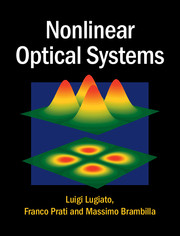Book contents
- Frontmatter
- Dedication
- Contents
- Preface
- Part I Models, propagation, stationary phenomena
- Part II Dynamical Phenomena, Instabilities, Chaos
- 18 Some general aspects in nonlinear dissipative dynamical systems
- 19 Special limits in the single-mode model
- 20 The linear-stability analysis of the Maxwell–Bloch equations
- 21 Adiabatic elimination in the complete Maxwell–Bloch equations
- 22 Dynamical aspects in the laser
- 23 Single-mode and multimode operation in inhomogeneously broadened lasers
- 24 Dynamical aspects in optical bistability
- 25 Self-pulsing in other optical systems
- Part III Transverse optical patterns
- Appendix A The Routh–Hurwitz stability criterion
- Appendix B Calculation of the oscillatory instability boundary
- Appendix C Coefficients of the characteristic equation (20.20)
- Appendix D Derivation of equations (20.27) and (20.28)
- Appendix E Coefficients of equations (20.60) and (20.61)
- Appendix F The exact boundary of the Risken–Nummedal–Graham–Haken instability
- Appendix G Nonlinear analysis of the roll solution
- References
- Index
19 - Special limits in the single-mode model
from Part II - Dynamical Phenomena, Instabilities, Chaos
Published online by Cambridge University Press: 05 March 2015
- Frontmatter
- Dedication
- Contents
- Preface
- Part I Models, propagation, stationary phenomena
- Part II Dynamical Phenomena, Instabilities, Chaos
- 18 Some general aspects in nonlinear dissipative dynamical systems
- 19 Special limits in the single-mode model
- 20 The linear-stability analysis of the Maxwell–Bloch equations
- 21 Adiabatic elimination in the complete Maxwell–Bloch equations
- 22 Dynamical aspects in the laser
- 23 Single-mode and multimode operation in inhomogeneously broadened lasers
- 24 Dynamical aspects in optical bistability
- 25 Self-pulsing in other optical systems
- Part III Transverse optical patterns
- Appendix A The Routh–Hurwitz stability criterion
- Appendix B Calculation of the oscillatory instability boundary
- Appendix C Coefficients of the characteristic equation (20.20)
- Appendix D Derivation of equations (20.27) and (20.28)
- Appendix E Coefficients of equations (20.60) and (20.61)
- Appendix F The exact boundary of the Risken–Nummedal–Graham–Haken instability
- Appendix G Nonlinear analysis of the roll solution
- References
- Index
Summary
The relaxation rates κ, γ⊥ and γ∥ which appear in the single-mode model are irrelevant for the stationary state. Instead, their values become critical when we consider dynamical, i.e. time-dependent, phenomena. In particular, they control the possibility of eliminating adiabatically some of the variables in play, thus reducing the complexity of the problem. In this chapter we first illustrate, in Section 19.1, the useful laser classification introduced by Arecchi. Next, in Section 19.2, we discuss the dynamical behavior of the solutions of a model obtained from the single-mode model (derived in Chapter 12) by performing the adiabatic elimination of the atomic variables, which procedure is called the good-cavity limit in the literature. Section 19.2.1 is devoted to the case of the free-running laser (class-A laser) and discusses in particular, at the end, the cubic single-mode laser model which is the simplest model capable of describing a laser. On the other hand, in Section 19.2.2 we discuss the case of optical bistability in the good-cavity limit.
If we eliminate adiabatically the atomic polarization only, we obtain, instead, the single- mode rate equations which are discussed in Section 19.3. In particular, Section 19.3.1 concerns the case of class-B lasers and focusses especially on the phenomenon of relaxation oscillations. Special attention is paid to demonstrating the equivalence of the model which describes class-B lasers to the rate-equation laser model derived in Chapter 1 and the semiconductor laser model obtained in Chapter 16. In Section 19.3.2 we describe the generation of a giant pulse in class-B lasers, a phenomenon which is called active Q- switching.
The final section, Section 19.4, deals with the model obtained by adiabatically eliminating the field variable in the so-called bad-cavity limit.
Classification of lasers
Arecchi [243] identifies three especially important kinds of laser, which he calls class-A, class-B and class-C lasers, respectively.
(1) Class-A lasers are characterized by the condition
κ ≪ γ⊥, γ∥.
In this case the atomic variables can be adiabatically eliminated. The He–Ne laser, argon laser and quantum-cascade laser belong to this class.
- Type
- Chapter
- Information
- Nonlinear Optical Systems , pp. 219 - 232Publisher: Cambridge University PressPrint publication year: 2015



